Liv’ED It is an ED original style where we write about our personal experiences on experiencing and reviewing any app/place/website/experience which gives us a feeling of coming back for more.
When I was in school I inquired about a distinct form of art that decorated the walls of my art class as it had caught my eye. My teacher told me the art is called ‘Madhubani Kala’.
I was fascinated by it even back then but the busy school schedule made it impossible for me to give any attention to it. I had more or less forgotten about it until a week ago when I saw a mural on the streets which was done in Madhubani style.
This incident reignited my interest and I decided I’ll steal away some time for this childhood preoccupation of mine.
What Is Madhubani Art?
These paintings are said to have originated from the Mithila region of Bihar and hence are sometimes also called Mithila paintings.
It is believed that these paintings were in existence since the times of Ramayana, King Janaka of Mithila commissioned the artists to create a painting depicting his daughter Sita’s wedding with Lord Rama.
The paintings are marked by their geometric and symmetrical patterns. People also employ their hands, twigs, pen nibs, matchsticks, etc. for the creation of these paintings.
Like most Indian art forms the deities hold a prominent spot in Madhubani paintings. Shiva and his wrath, Ganesha and his blessings, Radha-Krishna lost in love are often the themes and subjects in this ‘Kala’.
After browsing the internet for hours, to find out more about Madhubani art, I was ready to attempt creating a painting of this style.
So here’s my experience and you can LivED with me:
First, gather your art weapons. Though traditionally in Madhubani paintings natural extracts, cow dung, the colors derived from plants and other natural sources like Lampblack and ochre are used, in recent times contemporary artists are a bit lax about these things.
For my painting, I used Acrylic colors, black sketch pens and ball pens on a hand-made sheet.
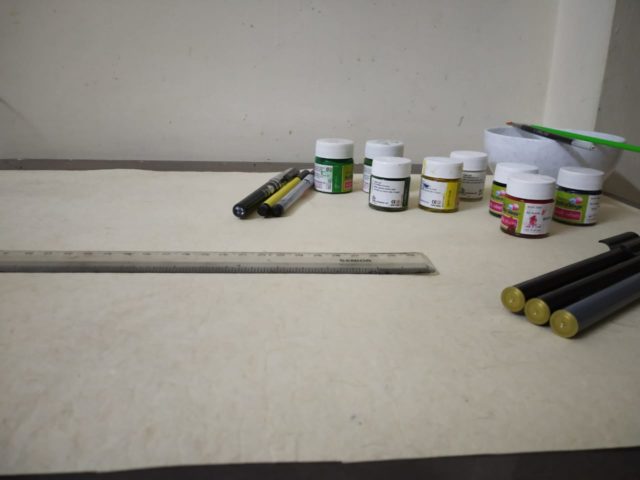

Then using a sketch that I Googled, I started drawing with a pencil.

I made the border first. I favor thick borders so I drew big flowers on the sides and triangles at the fringes.
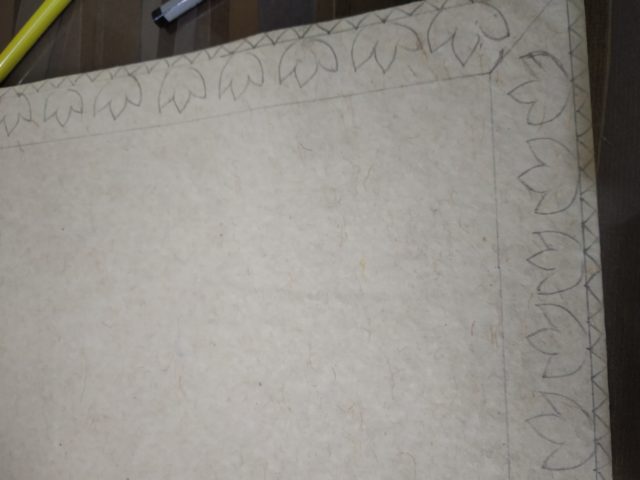
Animals like deers, fish, elephants, peacock, etc. are a regular occurrence in such paintings. So for my painting, I too drew a peacock.
A thing to remember here is to limit the usage of erasers as it will damage the sheet and draw the outlines lightly otherwise the sheet will develop a blackish hue.

Once this was done I used a black sketch pen to make the design more visible and impressive. This way I didn’t have to squint my eyes any longer to examine my progress.
Also Read: Indian Paintings: Revisiting The Folk Art Of India
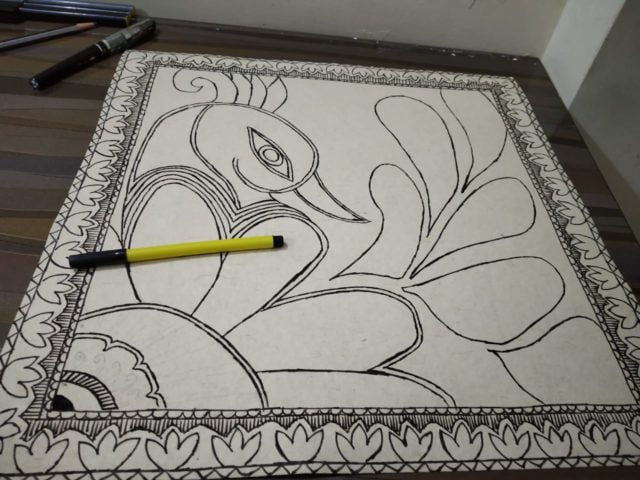
After this, it was time to color it. The paintings are usually brightly colored and intricate in their designs. Floral patterns are used everywhere to cover-up any left-out space. This is done to give it a more mosaic look.
I applied the primary colors red, blue, yellow on the painting. I am no good with mixing colors to get various shades so I opted to keep it simple by using only the bottles that were provided in my acrylic kit.
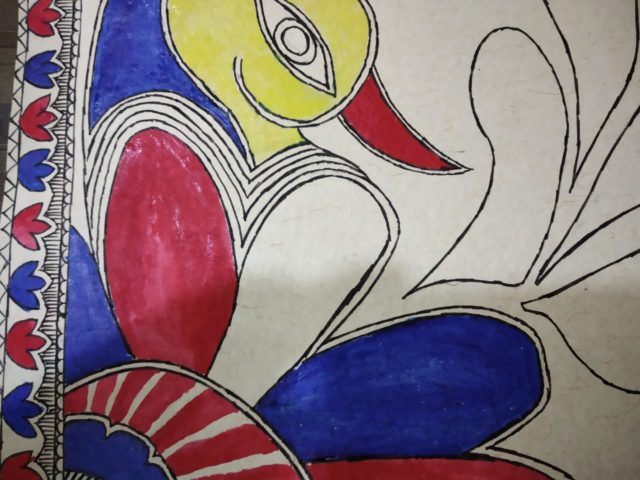
The floral boundaries were also painted in similar shades. Although at first, it looked easy, I had forgotten something about myself. As a child, I always had problems coloring within the confines of the boundaries, here too my brush strokes spilled out and smudged some areas. And I coated some parts more than needed.
But still, I persisted.
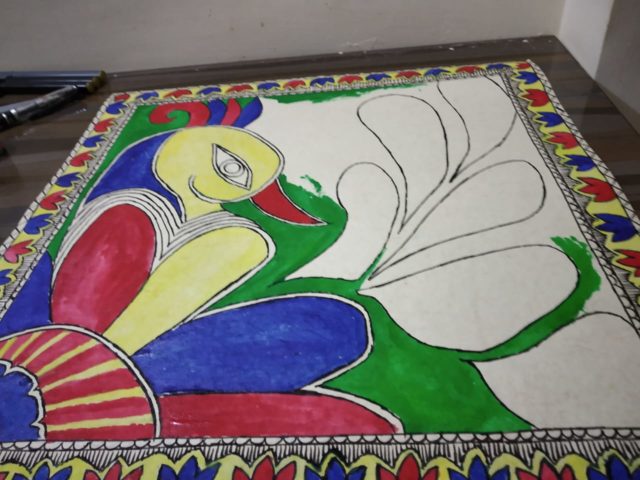
I tinted the peacock’s feather in black and filled the rest of the space with green which was an intentional contrast on my part and is also done by many other artists.

Then I drew over the paint with a sketch pen for adding more details and patterns. I didn’t stop until the whole painting was covered with straight and wavy lines, numerous circles, leaves, and dots. This isn’t too difficult if one has drawn mehendi designs on palms before or at the back of notebooks as I have, during tedious and boring lessons.

For a finishing touch, I dabbed white paint in shape of dots over the feathers and the result was this:
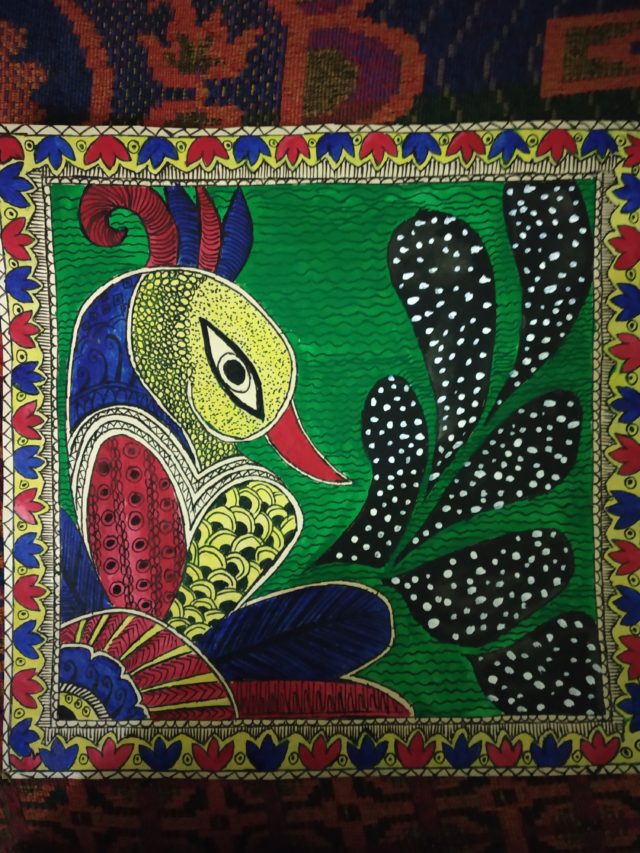
I’m a novice at this so it didn’t turn out great but the intention behind the painting was to spend some leisure hours this way and I confess I had a great time. The hours sneaked by without me becoming aware of it and I was at peace I so rarely feel these days.
So, it’s safe to say this venture was not a complete failure.
In the future, I do hope to continue with the studying of these beautiful designs and maybe I’ll improve eventually. Already I’m thinking of drawing a scene with Radha-Krishna dancing to mark the approaching Navratri.
Did you enjoy experiencing Madhubani art with us? Let us know in comments below.
Image Credits: Author’s own, Google Images
Sources: Craftsvilla, Culture India, Color Of India
Find The Blogger: @ishitabajpai6
Other Recommendations:






























Aap is Google per photos bhejte Rahana please